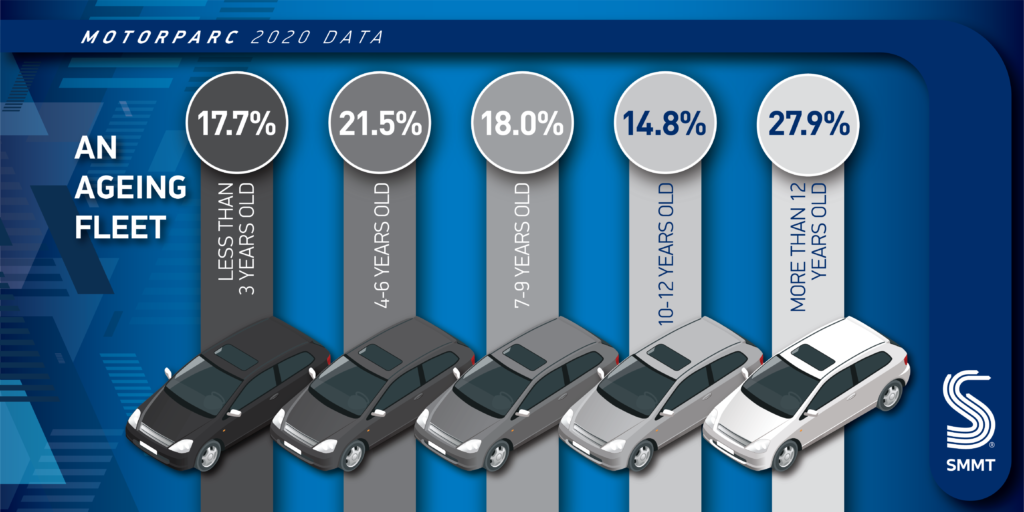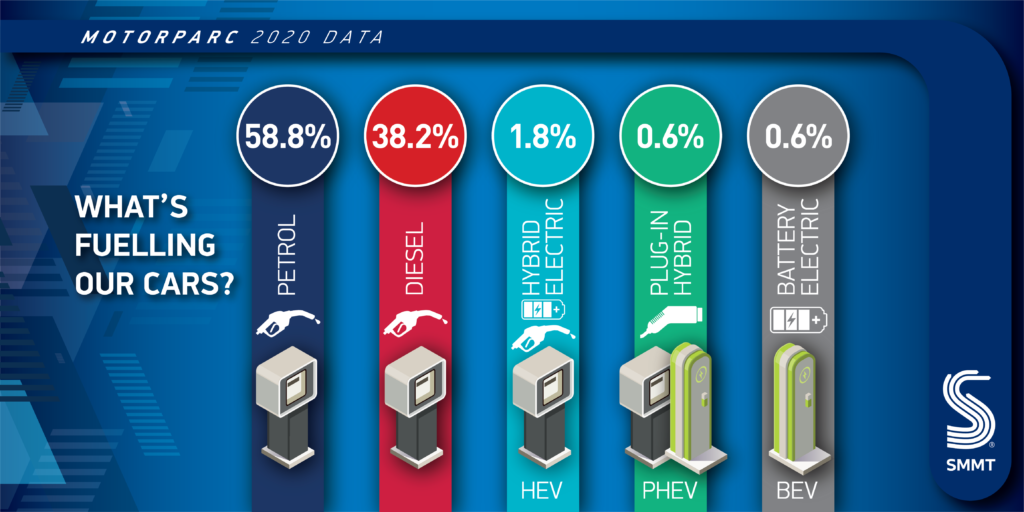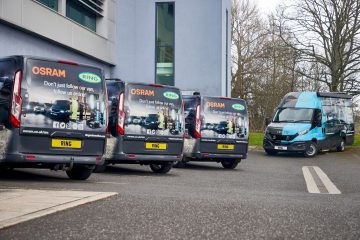The UK has seen its first drop in vehicle numbers on the roads since 2009, as the COVID-19 pandemic impacted not only usage, but size and age of the country’ car parc.
At the end of 2020, there were 40,350,714 vehicles being used, according to Motorparc data released by the SMMT. This is made up of 35,082,800 cars (down 0.2% compared to 2019), 4,604,861 light commercial vehicles (up 1.7%), and the rest split between heavy goods vehicles (down 3.1%) and buses (down 10.7%).
The fall in car numbers was a result of the dramatic fall in new-vehicle sales during 2020. With dealerships closed for much of the year, and online platforms still in development, the industry was hit hard by the pandemic.
Old age emissions
This meant that many car owners opted to keep their older models instead. The resulting economic impact would also have played a part in such decisions. This has resulted in the oldest average age across the country’s car parc since records began.

The average car on UK roads was built in 2011, while almost 10 million cars have been in service since 2008 or earlier. While this is testament to the durability and quality of modern vehicles, an ageing fleet risks stalling the UK’s attempts to reduce emissions.
A new car from 2020 emits, on average, 112.8g/km of CO2, which is 18.3% better than a model registered in 2011. Fleet renewal is essential if the UK is to reach its net zero target, with both conventional and alternatively fuelled vehicles having a significant role to play in the transition. The aftermarket also has a role to play, ensuring vehicles have the correct and best quality emissions components fitted, to ensure these older cars do not cause more pollution than necessary.
Long road ahead for BEV
As part of the journey towards zero emission motoring, the number of battery electric vehicles (BEVs) on UK roads increased by 114.3% to a record high of 199,085, while plug-in hybrid vehicles (PHEVs) also saw their numbers increase by 35.2% to 239,510.

However, combined, they represented just 1.3% of all cars on our roads – emphasising the importance of replacing older vehicles with newer, cleaner ones. Hybrid electric vehicles (HEVs) saw their numbers grow by a fifth to 621,622 cars. Petrol car volumes remained stable, down -0.2%, with diesel falling 2.3%. Combined, internal combustion engine (ICE) models accounted for 97.1% of the total parc – or 34,018,599 units.
“With the pandemic putting the brakes on new vehicle uptake in 2020, the average car on our roads is now the oldest since records began some 20 years ago, as drivers held on to their existing vehicles for longer,” said Mike Hawes, chief executive of the SMMT. “The technology is changing, however, albeit slowly. Despite massive growth last year, just one in 80 vehicles is a plug-in electric car – while nearly 10 million petrol and diesel cars dating back to before 2008 remain on our roads. Encouraging drivers to upgrade to the newest, cleanest lowest emission cars, regardless of fuel source, is essential for the UK to meet its ambitious climate change targets.”
Did you know?
Some more interesting figures from the motoring world, provided by the SMMT
- The number of female registered keepers continues to increase to record numbers with 35.1% of cars registered to women in 2020, the equivalent of 12.3 million units. A further 51.5% of cars were registered to males. The remainder are either registered to companies or the keeper’s gender was not specified.
- There are 4.9 million more vehicles registered for use on British roads than there were in 2010, an increase of 13.7% from 35,478,652 to 40,350,714.
- In 2010, black was the third most popular coloured car with 5,047,874 units. A decade later, it is now the most popular paint, with 7,109,558 cars in the colour.
- Multi-coloured, pink and maroon coloured cars are the least common, equating to a combined total of only 0.2% of the parc.
- In 2019, white was the most popular colour for plug-in cars, however, this has now been replaced by black. White and grey complete a monochrome podium.
- The top three most common cars in use in 2020 were the Ford Fiesta (1.6m), Ford Focus (1.2m) and Vauxhall Corsa (1.1m), exactly the same models as a decade earlier in 2010.
- Manual cars continue to dominate the parc, with seven in 10 UK cars using these gearboxes.
- Automatic model use has grown by over half a million units to 10,454,067 cars since 2019.
- Specialist sports cars saw a 2.6% rise in ownership last year, whilst upper mediums declined by -4.7%.
- Outside of central London (WC and EC postcodes), residents of Worcester are the most likely to ‘drive British’, with UK-built cars accounting for 19% of all registrations.
- Excluding central London, the Shetland Islands have the fewest cars registered, with 12,768 on the road.




You must be logged in to post a comment.